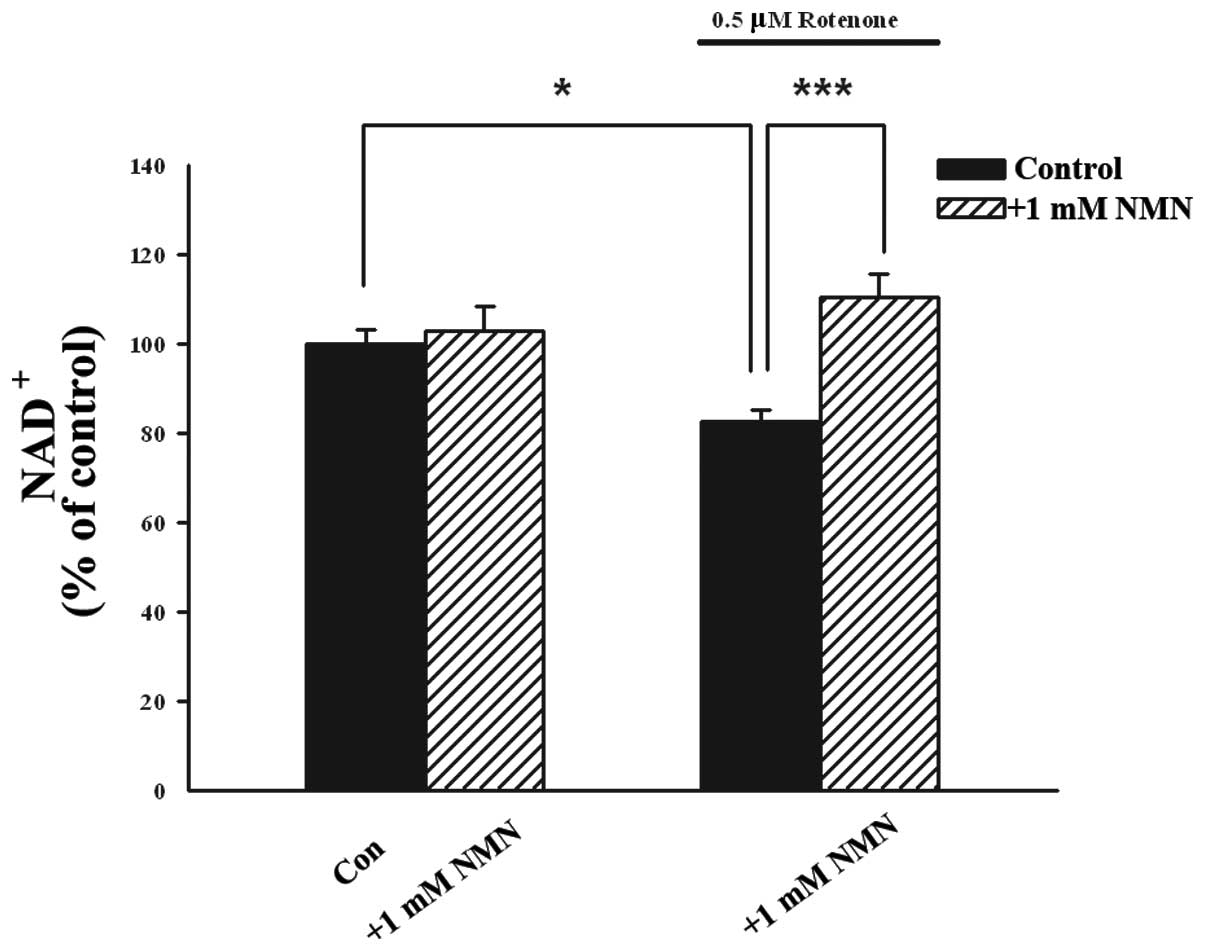|
1
|
Ying W: NAD+ and NADH in
cellular functions and cell death. Front Biosci. 11:3129–3148.
2006.
|
|
2
|
Ying W: NAD+/NADH and
NADP+/NADPH in cellular functions and cell death:
regulation and biological consequences. Antioxid Redox Signal.
10:179–206. 2008.
|
|
3
|
Xia W, Wang Z, Wang Q, et al: Roles of
NAD(+)/NADH and NADP(+)/NADPH in cell death. Curr Pharm Des.
15:12–19. 2009. View Article : Google Scholar : PubMed/NCBI
|
|
4
|
Alano CC, Ying W and Swanson RA:
Poly(ADP-ribose) polymerase-1-mediated cell death in astrocytes
requires NAD+ depletion and mitochondrial permeability
transition. J Biol Chem. 279:18895–18902. 2004. View Article : Google Scholar : PubMed/NCBI
|
|
5
|
Ying W, Garnier P and Swanson RA:
NAD+ repletion prevents PARP-1-induced glycolytic
blockade and cell death in cultured mouse astrocytes. Biochem
Biophys Res Commun. 308:809–813. 2003.
|
|
6
|
Wang S, Xing Z, Vosler PS, et al: Cellular
NAD replenishment confers marked neuroprotection against ischemic
cell death: role of enhanced DNA repair. Stroke. 39:2587–2595.
2008. View Article : Google Scholar : PubMed/NCBI
|
|
7
|
Ying W, Wei G, Wang D, et al: Intranasal
administration with NAD+ profoundly decreases brain
injury in a rat model of transient focal ischemia. Front Biosci.
12:2728–2734. 2007.
|
|
8
|
Fearnley JM and Lees AJ: Ageing and
Parkinson’s disease: substantia nigra regional selectivity. Brain.
114:2283–2301. 1991.
|
|
9
|
Beal MF: Mitochondria, oxidative damage,
and inflammation in Parkinson’s disease. Ann NY Acad Sci.
991:120–131. 2003.
|
|
10
|
Bredesen DE, Rao RV and Mehlen P: Cell
death in the nervous system. Nature. 443:796–802. 2006. View Article : Google Scholar : PubMed/NCBI
|
|
11
|
Simola N, Pinna A and Fenu S:
Pharmacological therapy of Parkinson’s disease: current options and
new avenues. Recent Pat CNS Drug Discov. 5:221–238. 2010.
|
|
12
|
Beal MF: Therapeutic approaches to
mitochondrial dysfunction in Parkinson’s disease. Parkinsonism
Relat Disord. 15(Suppl 3): S189–S194. 2009.
|
|
13
|
Olanow CW: The pathogenesis of cell death
in Parkinson’s disease - 2007. Mov Disord. 22(Suppl 17): S335–S342.
2007.
|
|
14
|
Bové J, Prou D, Perier C and Przedborski
S: Toxin-induced models of Parkinson’s disease. NeuroRx. 2:484–494.
2005.
|
|
15
|
Ying W and Swanson RA: The
poly(ADP-ribose) glycohydrolase inhibitor gallotannin blocks
oxidative astrocyte death. Neuroreport. 11:1385–1388. 2000.
View Article : Google Scholar : PubMed/NCBI
|
|
16
|
Ying W, Han SK, Miller JW and Swanson RA:
Acidosis potentiates oxidative neuronal death by multiple
mechanisms. J Neurochem. 73:1549–1556. 1999. View Article : Google Scholar : PubMed/NCBI
|
|
17
|
Roy MK, Takenaka M, Kobori M, Nakahara K,
Isobe S and Tsushida T: Apoptosis, necrosis and cell
proliferation-inhibition by cyclosporine A in U937 cells (a human
monocytic cell line). Pharmacol Res. 53:293–302. 2006. View Article : Google Scholar : PubMed/NCBI
|
|
18
|
Ma Y, Chen H, Xia W and Ying W: Oxidative
stress and PARP activation mediate the NADH-induced decrease in
glioma cell survival. Int J Physiol Pathophysiol Pharmacol.
3:21–28. 2011.PubMed/NCBI
|
|
19
|
Nie H, Chen H, Han J, et al: Silencing of
SIRT2 induces cell death and a decrease in the intracellular ATP
level of PC12 cells. Int J Physiol Pathophysiol Pharmacol. 3:65–70.
2011.PubMed/NCBI
|
|
20
|
Zimmermann M and Meyer N: Annexin V/7-AAD
staining in keratinocytes. Methods Mol Biol. 740:57–63. 2011.
View Article : Google Scholar : PubMed/NCBI
|
|
21
|
Alano CC, Garnier P, Ying W, Higashi Y,
Kauppinen TM and Swanson RA: NAD+ depletion is necessary
and sufficient for poly(ADP-ribose) polymerase-1-mediated neuronal
death. J Neurosci. 30:2967–2978. 2010.
|
|
22
|
Huang F, Vemuri MC and Schneider JS:
Modulation of ATP levels alters the mode of hydrogen
peroxide-induced cell death in primary cortical cultures: effects
of putative neuroprotective agents. Brain Res. 997:79–88. 2004.
View Article : Google Scholar
|
|
23
|
Schulz JB: Anti-apoptotic gene therapy in
Parkinson’s disease. J Neural Transm Suppl. 467–476. 2006.
|
|
24
|
Liou AK, Clark RS, Henshall DC, Yin XM and
Chen J: To die or not to die for neurons in ischemia, traumatic
brain injury and epilepsy: a review on the stress-activated
signaling pathways and apoptotic pathways. Prog Neurobiol.
69:103–142. 2003. View Article : Google Scholar : PubMed/NCBI
|

















